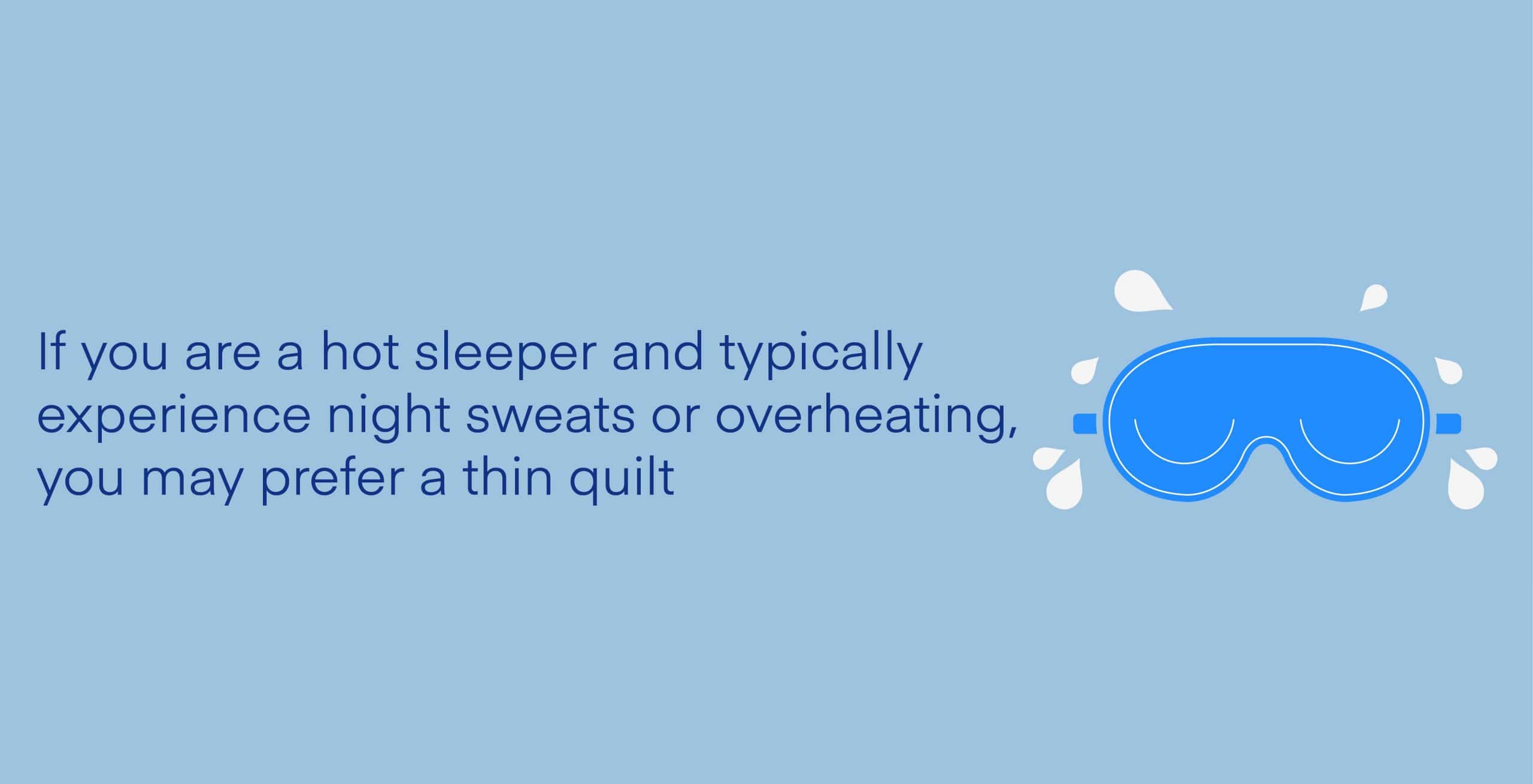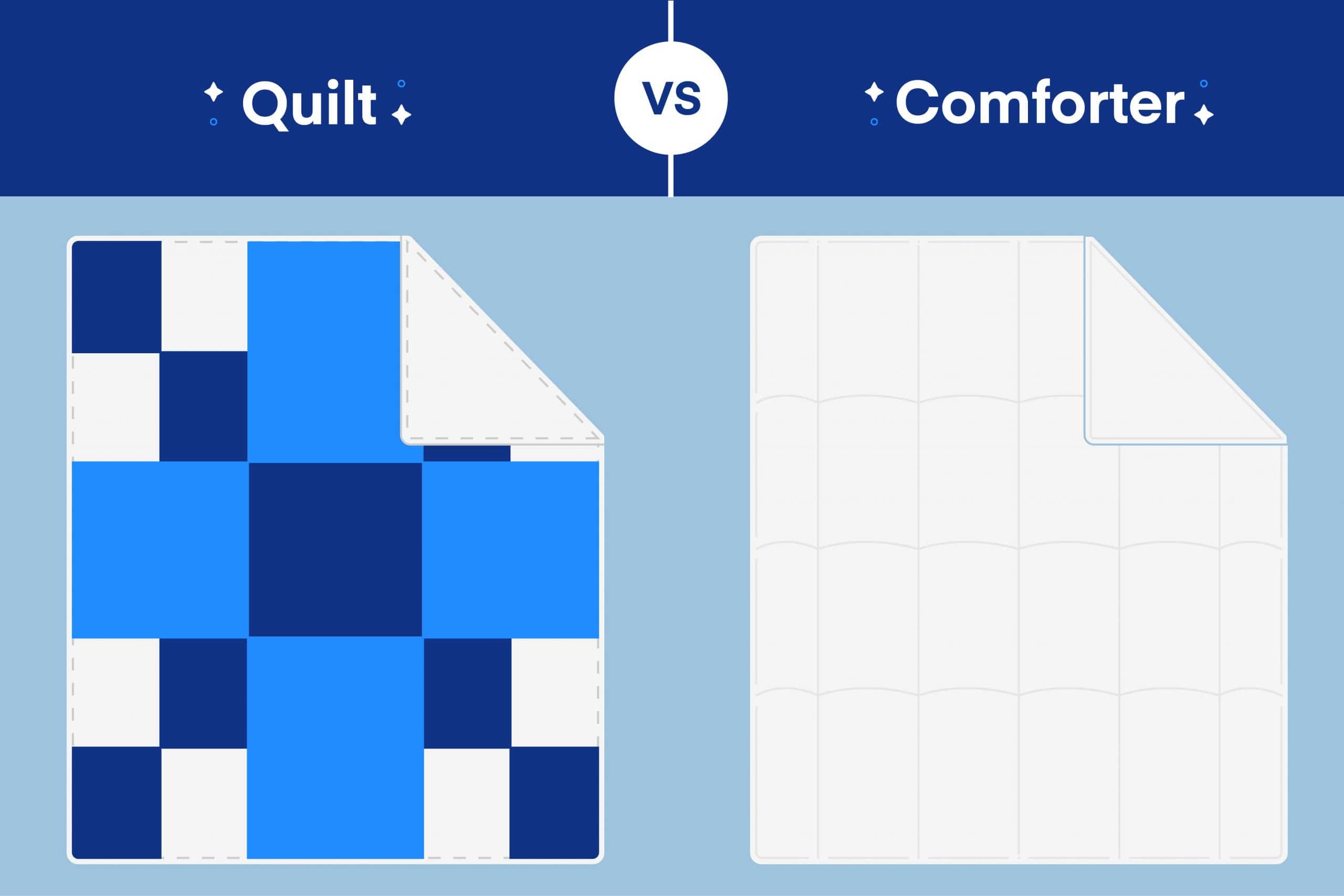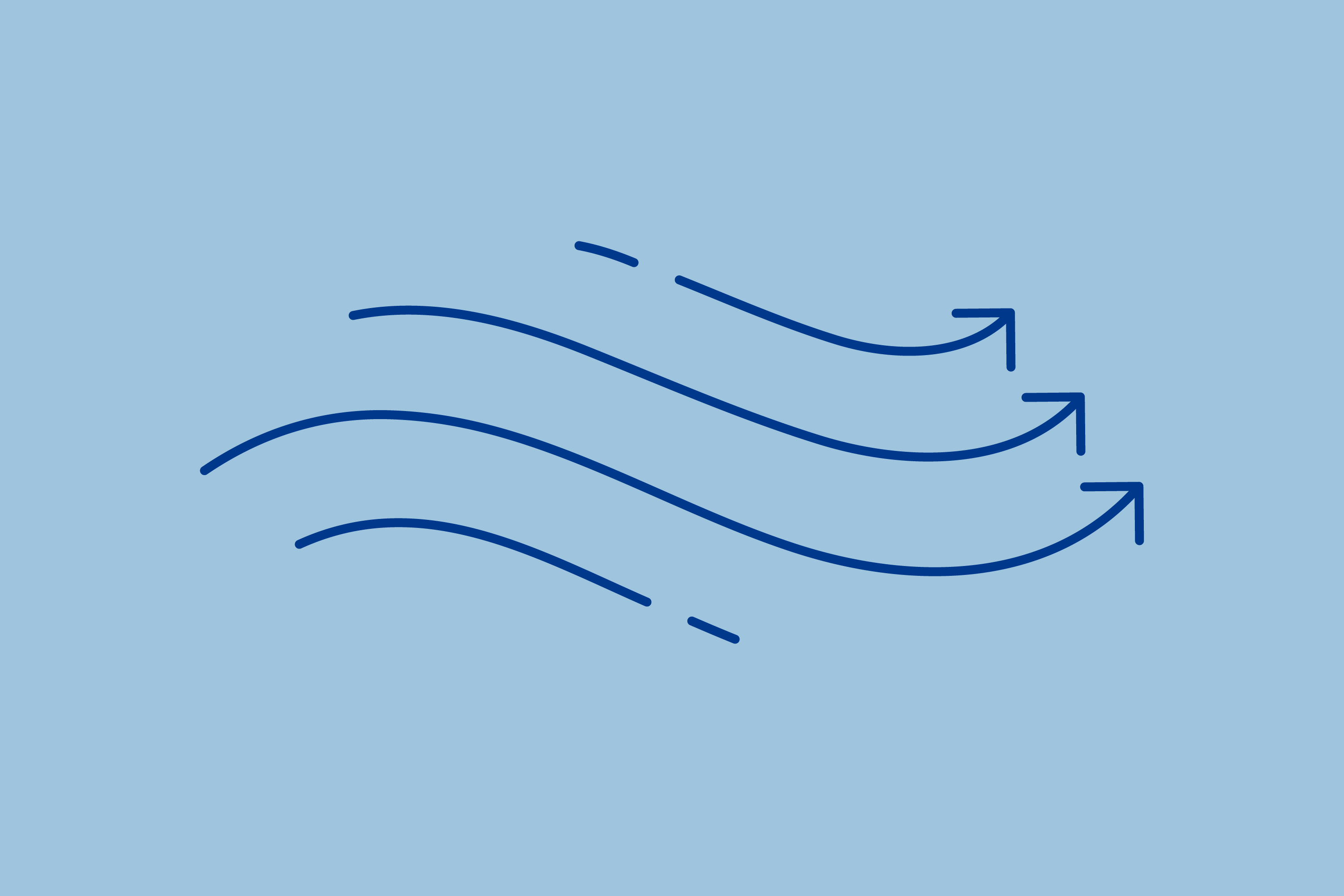Key Takeaways
- Differences in Construction and Material: Quilts are made of three layers—top decorative fabric, bottom fabric, and a layer of batting in between. They are known for their intricate patterns and designs. In contrast, comforters have a simpler construction with a single piece of fabric on the top and bottom, filled with materials like down, wool, or cotton. Comforters are fluffier and have a more uniform appearance.
- Warmth and Comfort: Quilts provide less insulation and are thinner, making them suitable for hot sleepers or those in warmer climates. They can be used for decorative purposes and can be layered for added warmth. Comforters, on the other hand, are known for their fluffiness and high loft, providing warmth and comfort. They are a great choice for those in colder climates.
- Preference and Use Cases: The choice between quilts and comforters often depends on personal preference and specific use cases. Quilts are preferred by those who appreciate decorative bedding, want a heavier feel, or live in warmer environments. Comforters are favored by those who seek fluffy and luxurious bedding, prefer fewer layers on the bed, or live in colder regions.
The right bedding can make your sleep space more inviting. When you are cozy and surrounded by soft, comfortable materials, you are more likely to relax and drift off to sleep quickly. But, with so many options on the market, it can be difficult to determine the best style of bedding for you.
In this article, we explain the differences and similarities between quilts and comforters. Plus, we highlight why you might prefer one over the other. Read on to discover more about these two popular bedding styles.
What’s a Quilt?
A quilt consists of three layers—the top, bottom layer, and the batting. The quilt’s top layer is typically decorative and made of various pieces of fabric sewn together in a particular pattern.
These patterns can be simple or complex—some even connect to one’s heritage or culture. For this reason, quilts are often passed down through generations and become family heirlooms.
Unlike the top layer, the bottom of a quilt consists of one type of fabric that complements the design on the top. The material used for the top and bottom of the quilt is generally one hundred percent cotton because it is the most widely available and most durable fabric.
Quilts provide warmth and comfort when lounging on a sofa or chair, so they are usually found resting on the back of an armchair or couch. Quilts can also be placed on top of a bed as a decorative accent. Due to their intricate designs and patterns, they are frequently used as wall hangings, table cloths, table runners, or displayed on a quilt stand.
A thin layer of batting, generally made of wool, polyester, or cotton-poly blend, (typically 80 percent cotton and 30 percent polyester), sits between the top and bottom of the quilt. Wool batting is fuller and fluffier than batting made of 100 percent cotton and is best for colder climates.
One hundred percent cotton batting is thin and best for mild to warm climates. Cotton blends are the best choice for batting because they can provide warmth in the winter months, plus they are breathable enough for the summer months.
A traditional quilting stitch is used to connect the three layers of the quilt. Today, this stitch is often done by machine because it is faster and more accurate. However, quilt stitching has been done by hand for many years.
What’s a Comforter?
Like quilts, comforters are also made of three parts—the top, bottom, and filling. However, that is where the similarities end. While the top and bottom may be made with a printed fabric, comforters are not made with various pieces of material or sewn together with a traditional quilt stitch.
Instead, the top and bottom of a comforter, (also called the shell or case), are made with a single piece of fabric, typically a solid color or print. The two layers and filling are sewn together with a sew-through stitch and a baffle box construction. The sewn-through method goes through all layers of the comforter in a box or panel stitch design.
Box stitching is the most popular method of construction for comforters made with down. This method creates a grid format so each square can be filled with down feathers and clusters. Panel stitches run vertically along the comforter, creating uniform rows for the filling.
In addition to the sew-through stitches, comforters have a baffle box construction to give the filling more room to expand, creating a fluffier, high loft blanket. To create a baffle box, pieces of cloth are sewn inside the comforter to connect both sides of the shell, giving it a three-dimensional design.
Like quilts, the filling inside a comforter can vary. Those filled with duck or goose down are fluffy and luxurious. Those filled with wool and cotton are warm, but they may not have the same cloud-like softness of down.
The terms comforter and duvet are often used interchangeably, which can confuse shoppers. While comforters and duvets are similar, comforters have a finished look and can be used on their own. However, duvets are fluffier and have a down or down alternative filling. Plus, duvets should be paired with a duvet cover to prevent feather quills from sticking up through the cover.
Try Our Recover+ Comforter
Quick Guide: A 30-Second Summary
| Best Comforter Overall | Amerisleep Recover+ Comforter |
 Sleepers can feel like they’re tucked away under their own personal cloud when dozing with our Recover+ Comforter. It’s designed to feel cool and dry during the warmer months and toasty warm during the colder months, so you’ll never have to pack it away at any point in the year.
Sleepers can feel like they’re tucked away under their own personal cloud when dozing with our Recover+ Comforter. It’s designed to feel cool and dry during the warmer months and toasty warm during the colder months, so you’ll never have to pack it away at any point in the year.
The comforter takes its name from the Recover+ technology it contains, a material engineered to safely convert body heat into infrared energy. This feature boosts a person’s local bloodflow for more restorative rest.
If you want to reduce the time you’ll need to spend washing your comforter, we recommend pairing the Recover+ Comforter with our Percale Duvet Cover Set, available in four distinct patterns. Slip the cover over the comforter, then slip it off to toss in the washer.
The Recover+ Comforter is backed by a 1-year limited warranty. The warranty offers coverage on manufacturing or cosmetic defects, such as ripped seams from faulty sewing.
Difference Between Quilts and Comforters
While both quilts and comforters serve a similar purpose, the materials and construction of each give them an entirely different feel. Below, we outline the primary differences between quilts and comforters.
| Quilts | Comforters |
|---|---|
| Thinner and flatter blankets Heavier with minimal loft Have a unique design made with many different colors and patterns Can serve a decorative purpose Classical, more traditional aesthetic Can add warmth when made with a wool batting Used as a throw blanket or decorative coverlet | Fluffy with a more prominent three-dimensional design Lightweight and airy Made with one type of fabric, color, or print Typically used for warmth and comfort rather than decoration Modern aesthetic Can be warm when made with a down or down alternative filling Used as a primary blanket for comfort during sleep |
Which is Right For You?
Still not sure which style is right for you? Below, we outline who typically prefer a quilt and those who sleep best with a comforter.
Who is a Quilt Right For?



- Hot sleepers: Since quilts have less insulation and are thinner than a comforter, they provide less warmth. If you are a hot sleeper and typically experience night sweats or overheating, you may prefer a thin quilt.
- Those looking for more decorative bedding: Quilts can be used as decorative bed covers, which can help you change the look and feel of your bedroom. If you want to change your bedroom aesthetic more frequently, you may prefer to use a quilt. A quilt can also be placed on top of a comforter or at the foot of the bed for a more decorative look.
- Those who prefer a heavy blanket and many layers: Due to the various pieces of material, quilts tend to be thin but heavy. If you prefer bedding with more weight, a quilt may be right for you. You can also layer quilts with different types of blankets to add warmth.
Who is a Comforter Right For?
- Those who prefer fluffier, more luxurious bedding: Many people prefer to rest beneath a soft, fluffy blanket. If this is the case for you, you may want to choose a comforter over a quilt. Quilts have minimal loft and tend to be thin and heavy.
- Those who prefer fewer layers: When using a comforter, most sleepers do not add extra layers to their bed. If you prefer fewer layers, it is best to go with a comforter.
- Those who live in a colder climate: To achieve enough warmth with a quilt, you may need to layer it with other blankets. However, one warm comforter made with either down or wool should be warm enough on its own.
Frequently Asked Questions
Can you wash a quilt?
Most quilts are made of cotton and can be easily washed by hand or in a washing machine using warm water and a mild liquid detergent. You can dry your quilt in a dryer or hang it outside in direct sunlight. If your quilt is too large for your washing machine, you can take it to the laundromat and use an industrial-size machine.
Can you put a quilt over a comforter?
Yes! If you prefer extra layers and want to add warmth to your bed, you can place a quilt over your comforter. This is also a great way to display the intricate details and design of your quilt. However, if you have a fluffy down comforter beneath, a heavy quilt will weigh it down and cause it to lose some of its height.
Can you wash a comforter?
While most comforters can be machine washed, the best way to clean your comforter depends on the material it is made of. Those made of cotton can be washed in your machine at home. However, if you have a large comforter, such as a queen or king size, it is best to take it to a laundromat and use an industrial-sized machine.
Those made with down, silk, or wool may become damaged if soaked with water, so your comforter may require dry cleaning. To be sure, read the laundry care instructions carefully before washing.
What is the best comforter for summer?
The best comforters for summer are those with a lightweight, breathable shell and filling, such as Tencel, cotton, or microfiber. These fabrics do not trap heat and they help wick away moisture, ensuring sleepers stay cool and comfortable throughout the night.
What is a duvet cover?
A duvet cover is a removable cover for a duvet or down comforter. Ties inside the cover attach to the comforter to keep it from moving around during sleep. Buttons or a zipper closure along one side secure the comforter inside.
Conclusion
When choosing the right bedding, be sure to keep your comfort and sleep needs in mind. While decorative elements can enhance the look of your bedroom, they will not add comfort. Above all, your bedding should help you stay relaxed and cozy so you can fall asleep quickly and wake up refreshed.
About the author
April Mayer is a sleep expert and writer with a degree in exercise physiology. She has dedicated her career to exploring the relationship between sleep and productivity. Her insightful articles, such as "The Surprising Way Your Mood Might Be Messing With Your Productivity" and "Wake Up to More Productive Mornings," have been featured in reputable publications like Forbes, Greatist, Real Homes, Thrillist, Tom's Guide, and Eat This, Not That. With a passion for helping others lead more productive lives through restful sleep, April offers valuable expertise on foods and vitamins for better sleep. As a trusted member of the Early Bird team since March 2020, she continues to provide informative and well-researched content.
View all posts





